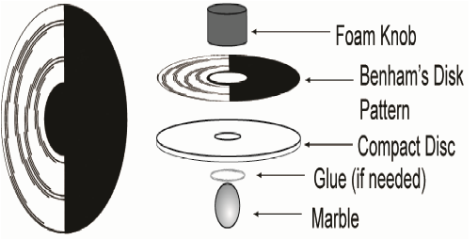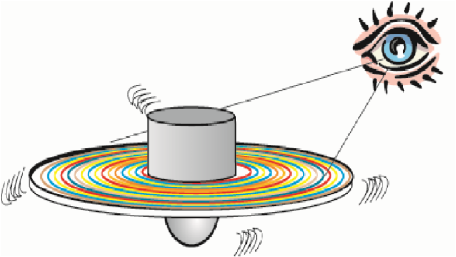How Do We Perceive Color?
Materials in the box
1. CD
2. Adhesive cylindrical foam piece
3. Marble
How do I begin?
1. Place the knob over the hole in the center of the CD, on the same side as the Benham’s Diskpattern. Peel-off the backing paper from the adhesive end of the foam, while squeezing the sides of the foam between your thumb and index finger.
2. Flip over the CD and press the marble into the hole from the opposite side of the knob. Be sure the marble contacts the adhesive on the foam. (If using another type of knob, glue as needed.) Press down hard to securely connect the knob, CD, and marble.
3. Spin the Benham’s Disk and watch the pattern carefully as it spins. Look for narrow arcs of color at different distances from the center of the circle. Different people may see different colors, and some
people will not notice any effect (this is normal).
4. Do the colors observed change as the disk slows down? Reverse the direction of the spinning and see what happens.
What just happened?
Color sensing nerves, called cones, are located on the retina in the back of the eye. Cones come in 3
types: red-sensitive, green-sensitive, and blue-sensitive. White light is a mix of all the colors in the visible spectrum. White light causes all three cones to fire, and our brain tells us we are seeing white. Black is the absence of color. Black causes no cones to fire, and our brain tells us we are seeing black.
It takes a small amount of time for each cone to fire. This is called “latency.” After a cone fires, it takes a
brief time to shut off even after the color is removed. This is known as “persistence.” Each of the different
types of cone (red, green and blue) may have a slightly different latency and persistence.
Notice the pattern of curved black and white lines on the Benham’s Disk. Recall that white causes all 3
cones to fire, and black causes them to turn off. As you watch the pattern spin, each transition from black
to white should trigger all 3 cones to fire at the same time. However, as the different cones turn on and off
rapidly, their different latency and persistence responses cause them to get “out of sync.” So, instead of
firing together when your eye sees a transition from black to white, the cones may fire at different times.
As a result, your brain interprets the information as color!
Interestingly, scientists cannot explain why only certain patterns generate the effect. Random black and
white patterns do not tend to produce the illusion of color. Somehow, the length of the arcs of black and
their locations around the disk are important – but the details continue to elude explanation.
Exploring Further
1. Have different people observe the spinning pattern and record the colors perceived. What are the most common colors reported?
2. What percentage of the people tested see no colors?
3. Do family members see the same colors?
1. CD
2. Adhesive cylindrical foam piece
3. Marble
How do I begin?
1. Place the knob over the hole in the center of the CD, on the same side as the Benham’s Diskpattern. Peel-off the backing paper from the adhesive end of the foam, while squeezing the sides of the foam between your thumb and index finger.
2. Flip over the CD and press the marble into the hole from the opposite side of the knob. Be sure the marble contacts the adhesive on the foam. (If using another type of knob, glue as needed.) Press down hard to securely connect the knob, CD, and marble.
3. Spin the Benham’s Disk and watch the pattern carefully as it spins. Look for narrow arcs of color at different distances from the center of the circle. Different people may see different colors, and some
people will not notice any effect (this is normal).
4. Do the colors observed change as the disk slows down? Reverse the direction of the spinning and see what happens.
What just happened?
Color sensing nerves, called cones, are located on the retina in the back of the eye. Cones come in 3
types: red-sensitive, green-sensitive, and blue-sensitive. White light is a mix of all the colors in the visible spectrum. White light causes all three cones to fire, and our brain tells us we are seeing white. Black is the absence of color. Black causes no cones to fire, and our brain tells us we are seeing black.
It takes a small amount of time for each cone to fire. This is called “latency.” After a cone fires, it takes a
brief time to shut off even after the color is removed. This is known as “persistence.” Each of the different
types of cone (red, green and blue) may have a slightly different latency and persistence.
Notice the pattern of curved black and white lines on the Benham’s Disk. Recall that white causes all 3
cones to fire, and black causes them to turn off. As you watch the pattern spin, each transition from black
to white should trigger all 3 cones to fire at the same time. However, as the different cones turn on and off
rapidly, their different latency and persistence responses cause them to get “out of sync.” So, instead of
firing together when your eye sees a transition from black to white, the cones may fire at different times.
As a result, your brain interprets the information as color!
Interestingly, scientists cannot explain why only certain patterns generate the effect. Random black and
white patterns do not tend to produce the illusion of color. Somehow, the length of the arcs of black and
their locations around the disk are important – but the details continue to elude explanation.
Exploring Further
1. Have different people observe the spinning pattern and record the colors perceived. What are the most common colors reported?
2. What percentage of the people tested see no colors?
3. Do family members see the same colors?

Benham's Disk assembly

Optical Illusion

